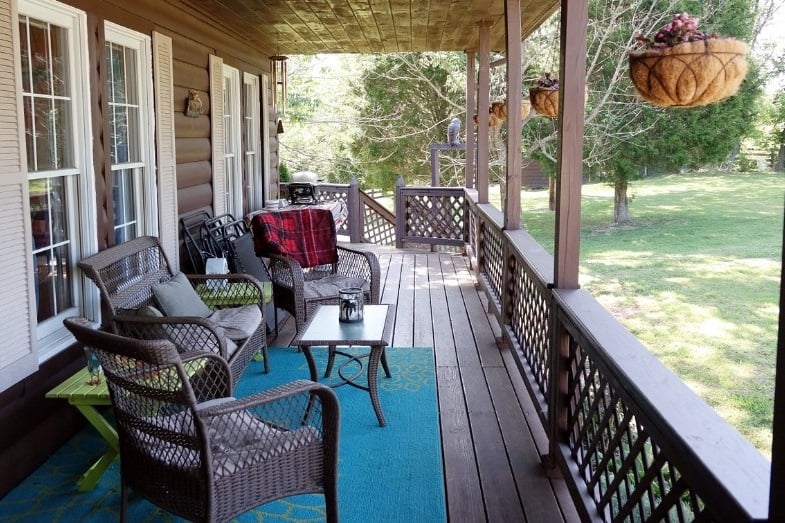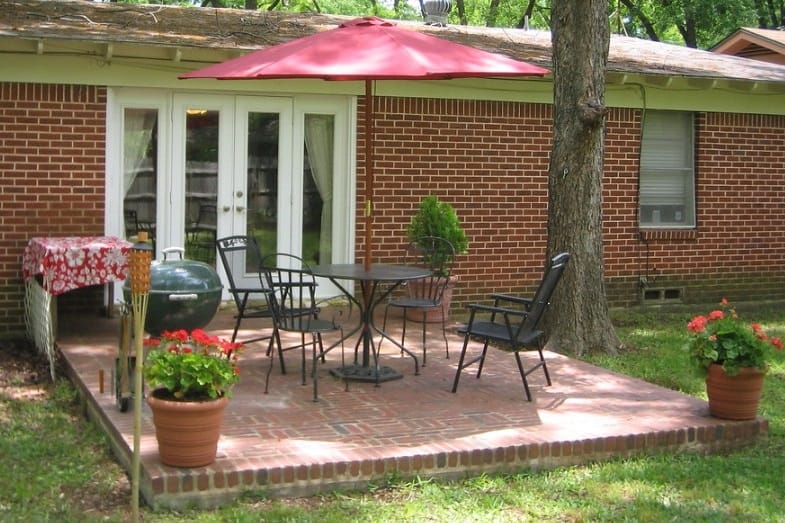What is the difference between a porch and a patio? There is often confusion between the terms porch and patio. The terms are used interchangeably nowadays; however, there are some technical differences between them. In this article, I will compare the patio vs porch and explain the difference between them.
Porch vs patio – what is the difference? The primary difference between a patio and a porch is how they are designed. A porch is attached to the house’s structure and is usually located at an entryway. A patio, however, is situated right next to the house, either in or on the ground.
Porches are also designed to adhere to the overall architectural design of the building it is attached to. Patios are separate from the home and are more part of the surrounding landscape.
Read on to know the differences between a porch vs patio so you can better decide which one fits your dream home.
Also, take a look at one of the best patio umbrellas for a porch or patio, the Abba Patio 9ft Patio Outdoor Umbrella.
Click here to see it on Amazon.
And a cool, classy accessory for any porch or patio, the Keter Pacific Cool 7.5 Gallon Outdoor Cooler.
Click here to see it on Amazon.
Porch Vs Patio – What is the Difference?
In the world of design, there is a fine line that separates patios and porches. A patio vs porch distinction is crystal clear in some regions, while it gets a little confusing in other places.
Porches are elevated structures attached to the house, while patios are at ground level with walls, paved floors, and a wood-framed roof for protection.
In other regions, such as Florida, where slab-on-grade foundations are most popular, the difference between a porch and a patio is less discernible. In these regions, porches and patios may be paved, outdoor living, and recreational spaces situated in front yards or backyards. Both can be designed with outdoor furniture and can either be with or without a roof.
To better understand their differences, let’s look at them individually.
What Is a Porch?
A porch is defined as an area located at the entryway of a home or building. The word in itself is derived from the old French word porche. It has a Latin root word meaning passage.
The construction and use of porches have existed since ancient times, such as the Apadana Palace built around 6th Century BC in Persepolis. Architecture in ancient Greece involved porches in the form of a peristyle, a type of porch characterized by a row of columns around a courtyard or building.
Functional Design
The reason behind the use of porches is simple. It allows ample space for guests to relax and pause before entering or after exiting a home. Also, having a porch at home creates a more hospitable and welcoming atmosphere.
A porch in a cozy home needs a nice set of lounge chairs. Check out the Best Choice Products Adjustable Recliners. These chairs are durable, comfortable, portable, and have a convenient, detachable tray.
Click here to see it on Amazon.
Types of Porches
Not all porches are designed the same. Some porches are large and spacious, while others are just enough for the entryway. Surprisingly, porches come in several different styles, which are all based on varying architectural traditions.
Here are some of the more popular styles:

- Portico – This style is characterized by columns, colonnades, and arches often seen in Italian style architecture.
- Lanai – Lanais originated from Hawaii. It is an open-sided area with a roofed porch and concrete stone floor. The same functionality of the Japanese engawa inspired the origins of its design.
- Stoop – It’s a small landing area covered by a roof on top. This style is suited for apartment buildings in urban areas.
- Screened Porch – Built or renovated to be surrounded by screens, creating an outdoor type of room with more semblance of privacy. It’s a popular choice for properties in Arizona, wherein it is aptly called Arizona room.
- Rain Porch (Carolina Porch) – This style is often seen in the Southern United States. It’s characterized by columns and a roof that extends a few feet past the porch structure, creating a covered patio.
- Veranda – It’s a large porch surrounding the whole facade, including the sides of a home or building. One example is The Grand Hotel on Mackinac Island, Michigan. It has the largest porch in the world, measuring 660 feet (200 meters) in length.
The below video shows some beautiful porch examples:
What Is a Patio?
Patio is a Spanish term that means courtyard. However, the term patio is now widely used as a general term for a particular architectural design. If you look up the dictionary definition of a patio, it says that it’s an outdoor area adjoining a house with a solid paved floor but without a roof. It is used during good weather for eating, relaxing, or just hanging out.
Patios take inspiration from the landscaping design around it, so its design is more relaxed, unlike a porch, wherein its look must adhere to the overall architectural plan of the house.
A patio is also an extension of a home or particular room, which is why it’s often used for recreation. It’s usually located in the backyard, where gardens, swimming pools, and other leisure activities take place.
Functional Design
If a patio is thoughtfully designed, it can extend the living space well into the outdoors.
For example, placing a patio near the kitchen connects and expands the cooking and dining space. A patio connected to a studio, garage, or office enlarges the activity space, allowing for a breath of fresh air, especially during stressful workdays. Also, connecting a patio to a living room or den can even provide more space for entertainment, as well as allow guests to just relax in the outdoors.
A patio is nice to have in your home as it promotes a relaxing ambiance. The best way to relax on a patio is when the sun is not too hot and a gentle breeze is blowing. Unfortunately, ideal weather is hard to come by these days due to the effects of global warming.
But don’t worry, you can still experience a restful day on a patio if you install an outdoor umbrella, such as the Abba Patio 9ft Patio Outdoor Umbrella.
Click here to see it on Amazon.
This sturdy outdoor umbrella will surely add a touch of sophistication to your patio’s overall look, not to mention the all-important UV protection for you and your guests. Its polyester fabric is fade-resistant and water repellent. Plus, the Abba Patio Umbrella comes in a wide range of colors and patterns.
It also has a sturdy 6-rib aluminum pole that guarantees superior strength support. You can easily tilt it with a push of a button and quickly close or open it with the crank. Moreover, it comes with a Velcro strap for convenient packing. With guaranteed quality and ease of use, this outdoor umbrella is an excellent choice for any patio.
Types of Patios
Factors such as outdoor space, the architectural style of the house, location, size, and budget can affect the construction of any type of patio. Below are several types of patios based on landscape shape or design:

- Entry Patio – This type of patio is a paved area in the front yard. It aims to liven up the front of the property and extend the living space when there is good weather.
- Detached/Freestanding Patio – An excellent choice for bigger properties with vast gardens and landscaping. It is best made with an accessible garden path to allow anyone who desires a quiet outdoor escape. Gazebos, fountains, and outdoor seating space can make this design even more spectacular.
- Wraparound Patio – Usually built surrounding the back and sides of a house to add more living space. It has similar features to a wraparound porch, except that it is not always covered, and takes up a larger outdoor space.
- U-shaped or L-shaped Patio – These types of patio hug the immediate exterior of the house, allowing for a natural transition from indoors to outdoors. It can also have access to at least a couple of rooms in the house.
- Multilevel Patio – This patio style is perfect for properties built on slopes or vast lot expansions. It has a continuity design through the use of steps or paths. A multilevel patio is an excellent choice for houses built on areas with beautiful outdoor views.
The below video shows some beautiful patio examples:
Patio Vs Porch – At a Glance
Now that you know the patio vs porch differences, you can choose which to add to your home for your next home project. To help you even further, here is a simple guide on the difference between porch and patio:
| FEATURE | PORCH | PATIO |
| Purpose: | Relaxation, casual entertainment, dining, or hanging out | Relaxation, casual entertainment, dining, or hanging out |
| Location: | Outside, attached to house structure, usually at the front of the house | Outside, separately built adjacent to the house structure, usually at the back of the house |
| Roof: | With | Without |
| Floor Material: | Tile, stone, brick, or wood | Poured concrete, stone, or brick |
| Price Range (including labor, materials, and installation): | $16,000 to $30,400 | $2,000-$4,000 |
| Minimum Skill Level Required: | Professional level | DIY |
| Appearance: | Follows the overall architectural design | Incorporated in the landscape design |
| Resale Value (after renovation): | Non-value adding but can affect how quickly a home sells due to increased appeal | Can be a marketable addition, depending on the materials used |
Whichever you prefer between the two, you and your guests must all be comfortable in the space. One important consideration when choosing porch or patio furnishing is how much value it can add to the area.
A good value-adding fixture is the Keter Pacific Cool 7.5 Gallon Outdoor Cooler:
Click here to see it on Amazon.
It is unlike any other cooler, thanks to its elegant and functional design. It features a pop-up lid that elevates to become a cocktail table and a hidden cooler with a 7.5-gallon capacity.
Its weather-resistant resin construction allows it to be a versatile piece used as a coffee or bar table, drink cooler, and even a hot tub side table. It is a beautifully constructed piece that would liven up any porch or patio!
Conclusion: Porch Vs Patio – What Is the Difference?
What are the differences between a porch and a patio?
- A porch serves as an entryway to the house, while a patio is usually located in the backyard, where there is more outdoor nature space.
- A porch is attached to the house structure and follows its architectural design. On the other hand, a patio is designed to be part of the landscaping design around the property.
- Both can be constructed with stone, brick, and poured concrete.
- A porch is usually shaded with a built-in roof while a patio takes advantage of the open air.
Designing your outdoor space is really up to you. Both porch and patio are great additions that can jazz up spaces intended for leisure, relaxation, and peace.
Depending on your location, there may be regulations on the uses, maintenance, and renovations of patios and porches. While a porch does not usually add extra value to your property, porch renovation and proper maintenance can affect how fast you can sell your property.
In contrast, a patio can increase the resell value of your property if it is thoughtfully constructed and made to expand the living space, creating a pleasant, overall feel.


![Milwaukee M12 Vs M18 [What Is the Difference Between Them?] milwaukee m12 vs m18](https://homecarezen.com/wp-content/uploads/2022/01/Milwaukee-m12-vs-m18-150x150.jpg)






![Read more about the article Eye on the Stove – What Is It? [All About the Stove Eye]](https://homecarezen.com/wp-content/uploads/2021/11/Eye-on-the-Stove-300x200.jpg)